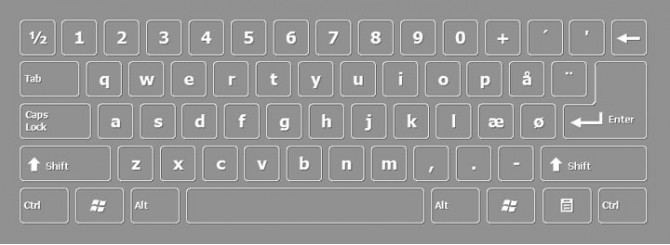DANISH DESKTOP KEYBOARD FREE DOWNLOAD
Danish
Danish keyboard layout
Both the Danish and Norwegian keyboards include dedicated keys for the letters Å/å, Æ/æ and Ø/ø, but the placement is a little different, as the Æ and Ø keys are swapped on the Norwegian layout. (The Finnish–Swedish keyboard is also largely similar to the Norwegian layout, but the Ø and Æ are replaced with Ö and Ä. On some systems, the Danish keyboard may allow typing Ö/ö and Ä/ä by holding the AltGr or ⌥ Option key while striking Ø and Æ, respectively.)
Danish orthography is the system used to write the Danish language. The oldest preserved examples of written Danish are in the Runic alphabet, but by the end of the High Middle Ages the Runes had mostly been replaced by the Latin letters.
Danish currently uses a 29-letter variant of Latin alphabet, identical to the Norwegian alphabet.
Standard Danish orthography has no compulsory diacritics, but allows the use of an acute accent for disambiguation. Most often, an accent on e marks a stressed syllable in one of a pair of homographs that have different stresses, for example en dreng (a boy) versus én dreng (one boy). It can also be part of the official spelling such as in allé (avenue) or idé (idea).
Less often, any vowel except å may be accented to indicate stress on a word, either to clarify the meaning of the sentence, or to ease the reading otherwise. For example: jeg stód op ("I was standing"), versus jeg stod óp ("I got out of bed"); hunden gør (det) ("the dog does (it)"), versus hunden gǿr ("the dog barks").[citation needed] Most often, however, such distinctions are made using typographical emphasis (italics, underlining) or simply left to the reader to infer from the context, and the use of accents in such cases may appear dated. A common context in which the explicit acute accent is preferred is to disambiguate en/et (a, indefinite article) and én/ét (one, numeral) in central places in official written materials such as advertising, where clarity is important.
Redskab[redigér
Computertastatur med dansk layout indeholdende Æ, Ø og Å.
Tastaturet kan være på en skrivemaskine eller være sluttet til en computer. Tastaturer findes i mange sprogvarianter og med flere forskellige placeringer af tasterne, hvor QWERTY-udgaven er den mest udbredte. QWERTY-tastaturet er en gammel opfindelse fra 1868, hvor man med vilje placerede meget anvendte bogstaver et stykke fra hvilepositionen, så man ikke kom til at taste for hurtigt. Dvorak-tastaturet er derimod skabt til at man kan skrive hurtigt.
Der findes også ergonomiske tastaturer som er "knækket" på midten og med et hængsel foroven, så hænderne kan arbejde under en mere naturlig form.
Nogle mennesker har fået en stærk aversion mod visse taster på tastaturet. F.eks. firmaejeren Pieter Hintjens, som ønsker caps-lock-tasten fjernet fra tastaturene. [1]
På næsten alle tastaturer er der to små forhøjninger på f- og j- tasterne i midten af tastaturet som en hjælp til at placere fingrene korrekt uden at skulle se ned på tastaturet. Dette kan, med lidt øvelse, bruges til at skifte hænder mellem hoveddelen af tastaturet og det numeriske tastatur – hvor der ligeledes er en forhøjet tast – uden at kigge. Forhøjningen bruges også i tifingersystemet hvor pegefingrene som udgangspunkt hviler på de to taster.
Frontype is easy to use multilingual user-friendly virtual onscreen keyboard that turns any keyboard to your language layout. Just add needed language as input and start to type!
Write a review about DANISH DESKTOP KEYBOARD FREE DOWNLOAD
Your Name:Your Review: Note: HTML is not translated!
Rating: Bad Good
Enter the code in the box below:






















